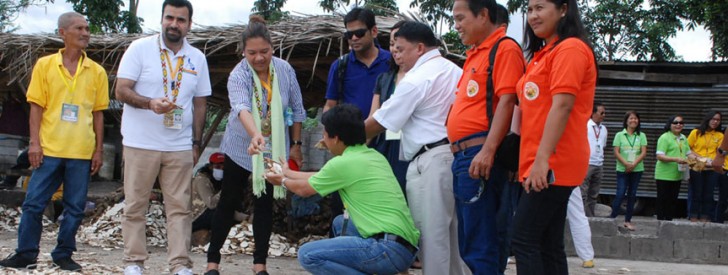 WB Team led by Task Team Leader for PRDP Carolina Geron (3rd from left), checks the pre-processed cassava granules during their visit to the cassava granules production and marketing project in Polomolok, South Cotabato on January 27, 2015 as part of the WB First Review Mission of PRDP.
WB Team led by Task Team Leader for PRDP Carolina Geron (3rd from left), checks the pre-processed cassava granules during their visit to the cassava granules production and marketing project in Polomolok, South Cotabato on January 27, 2015 as part of the WB First Review Mission of PRDP. Cassava production in the South gets a boost
General Santos City—Close to 500, 000 farmers and laborers in South Cotabato rely on cassava as a source of livelihood.
In 2012, the province produced a record yield of 34.5 metric tons (MT) per hectare—the highest in the country—transforming the province into a significant player in cassava production not only in Mindanao, but for the entire country.
During the same year, the province produced at least 32, 000 MT cassava granules, covering 99% of the total cassava tubers produced in South Cotabato.
With a gap of about 70,000 MT needed to fill in the 100,000 MT demand of commercial buyers in the province alone, the Philippine government will launch a P40 million-cassava granules production and marketing project which aims to improve the quality and volume of production, and increase farmers income thru value adding.
Enriching from Top to Bottom
Through the Philippine Rural Development Project (PRDP) of the Department of Agriculture (DA), the national government will support the production and marketing of cassava granules in the province with a financial assistance from the World Bank (WB) and through collaboration with the South Cotabato Local Government Unit (LGU) and Farmers’ Groups.
The DA-PRDP and Provincial LGU will share 80-20 percent (%) cash equity of the project cost respectively, while the Proponent Group—Polo Samahang Nayon Multipurpose Cooperative (POLOSN MPC)—will pitch in at least 20% equity of the total DA and LGU share, totaling to P39.33 million.
Through the project, the cooperative will provide inputs and planting materials to cassava farmers from 11 municipalities in South Cotabato, who in turn will sell their harvest to the POLO SN, providing for them a sure market for their produce at a competitive price. Farmers will also be provided technology and financing assistance by the cooperative.
POLO SN MPC, together with four other farmers’ cooperative namely: Topland MPC, San Jose MPC, Self-reliant MPC, and Poblacion Buto San Isidro Lampitak Agrarian Reform Beneficiary MPC will process and sell cassava granules to commercial feedmills in the province like San Miguel Foods and Agri Min, which collectively require 100, 000 metric tons of the processed cassava annually.
From Mindanao to the Whole Country
“PRDP is designed to deliver goods and services to improve incomes of farmers and fisherfolk, as well as enable beneficiaries to elevate into the next level of the value chain,” Undersecretary and PRDP National Director Emerson Palad said.
He stressed of the similar transparency and participatory qualities of the PRDP with its predecessor—the Mindanao Rural Development Program, adding that geo-tagging, as well as vulnerability and suitability mapping of sub-projects as important ingredient of the project’s efficient and transparent implementation.
“And so I urge the LGUs to commit the same level of partnership,” Palad said.
During the Mindanao leg of the First WB Review Mission on January 25-26, 2015, the Mindanao cluster presented more than P2.85 billion worth of sub-project portfolio comprising of enterprise development activities and infrastructure support.
WB Task Leader Carolina Figueroa-Geron expressed her support to the PRDP and the proponent LGUs stressing that enthusiasm, energy, and teamwork are needed to make the project work, adding that Mindanao and DA have been World Bank’s partner since 1990’s.
“We are here to support the project, and at the same time assess the readiness of the LGUs and the regions in implementing PRDP sub-projects, Geron said during the program.
Developing the Value Chain
The PRDP, a six year project implemented by the DA, aims to uplift the rural economy and increase incomes of farmers throughout the project life and thereafter.
The interventions put in place are based on a value chain analysis—a tool used to assess the status of a particular industry, the linkages and interplay of the different value chain players and identify upgrading strategies and interventions that could contribute to the development of the industry. It is the basis in identifying public and private investment opportunities which are identified by LGUs under the Provincial Commodity Investment Plan.
Cassava is a prime commodity in South Cotabato, considering high demand for the produce by feedmills, which supply feeds to the robust hog industry in Region 12.
Aside from cassava, the Mindanao cluster will initially support agri commodities like cacao, oil palm, seaweeds, rubber, abaca fiber, coconut, mango, and cardava banana under the PRDP. (Catherine Nanta, InfoACE NPCO)
